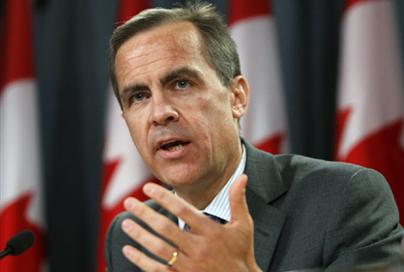
For the first time in nearly three years, the Bank of Canada, led by Governor Mark Carney, hiked its key interest rate.
OTTAWA -- For the first time in nearly three years, the Bank of Canada on Tuesday hiked its key interest rate by 25 basis points to 0.50%, as the domestic economy rebounds strongly against the backdrop of an "uneven" global recovery.
However, it signalled in its accompanying statement there is "considerable uncertainty" in the economic outlook given fiscal and financial unrest in Europe. As a result, further rate hikes "have to be weighed carefully" against global and domestic developments.
"This decision still leaves considerable monetary stimulus in place, consistent with achieving the 2% inflation target in light of the significant excess supply in Canada, the strength of domestic spending and the uneven global recovery," the central bank, led by governor Mark Carney, said.
That led some analysts to suggest there is no guarantee the central bank would raise rates again at its next scheduled meeting in mid-July.
"The July meeting is not a slam dunk," said Jonathan Basile, an economist at Credit Suisse in New York. "The downside risk is causing policymakers to lower the hawkish sails."
The statement's ambiguous, cautious tone led to a pullback in short-term bond yields and a US1¢ drop in the Canadian dollar. Douglas Porter, deputy chief economist at BMO Capital Markets, said it was as if the central bank was "almost bending over backward to indicate that this is not necessarily the start of a relentless campaign to crank rates higher."
Still, with the move, the Canadian central bank becomes the first among its Group of Seven peers to raise rates, and one of the few industrialized countries to do so. The last time the Bank of Canada raised its benchmark rate was in July of 2007.
The move signals higher borrowing costs for households and businesses that have loans tied to prime rates charged by chartered banks. (Prime tends to move in unison with the central bank's benchmark rate.)
The decision emerged a day after Statistics Canada reported the domestic economy reported its strongest quarterly performance in over a decade, as GDP expanded by a robust 6.1% in the three-month period ended March 31. The economy benefited from strong consumer spending, a robust goods-producing sector and an aggressive rebuilding of inventories by businesses.
There was a tug of war of sorts in the marketplace in the days leading up to Tuesday's decision about whether the Bank of Canada would pull the trigger and raise rates. A set of stronger-than-expected economic data, from retails sales to inflation, suggested a rate hike was warranted. Countering that, however, was market uncertainty over the spillover of fiscal problems in certain southern European nations, and the health of that continent's banking system.
In the end, the central opted to raise its key rate, and begin the process of withdraw extraordinary stimulus from the economy. But the Bank of Canada's statement explaining the rate hike went to some length to acknowledge the present risks to the global and domestic outlook.
"The global economic recovery is proceeding but is increasingly uneven across countries," the central bank said, noting the strong momentum in emerging economies and the "possibility" of renewed weakness in Europe.
The recovery in "most" developed economies remains "heavily dependent" on low interest rates and government spending, it added.
"In general, broad forces of household, bank and sovereign deleveraging will add to the variability, and temper the pace, of global growth," the statement said.
In Europe, rising yields on bonds issued by mostly southern European economies, or Club Med, are likely to result in higher borrowing costs and "more rapid fiscal tightening" in some countries, the bank said.
As of now, the spillover into Canada from events across the Atlantic have been "limited," in the central bank's view, to a "modest" drop in commodity prices and "some tightening" in financial conditions.
Nevertheless, the recovery in Canada is unfolding as the central bank envisaged, led by housing and consumer spending. But the Bank of Canada said it expects household spending -- up 4.4% annualized in the first quarter -- to slow down, and business investment to pick up the slack. Increased activity from the business sector would be crucial, the central bank said, to achieve "a more balanced recovery," which has to date relied heavily on highly indebted households.
The central bank sets its key interest rate with the goal of achieving and maintaining 2% inflation. Data for April showed inflation is nearing the target, with the headline inflation rate at 1.8% as six of the eight broad categories were up in the month. Meanwhile, the core rate, which strips out volatile-priced items, was at 1.9% in the month.
As a result of Canada's vigorous pace growth, the output gap -- or a measure of the amount of economic slack in the economy -- has shrunk considerably over the past year, to 2.3% from nearly 4%. As the gap shrinks, inflationary pressures tend to increase.
Meanwhile, in a related development linked with its interest-rate hike, the Bank of Canada said it was re-establishing the normal operating band of 50 basis points -- whereby its benchmark rate is halfway between the rate it pays chartered banks that hold deposits at the central bank, and the amount it charges private-sector lenders for loans.

